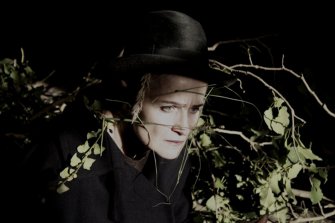Claudia Castellucci
Claudia Castellucci è drammaturga, coreografa e didatta. Formatasi nelle arti visive, ha composto testi, sia drammatici sia teorici, oltre a essere stata interprete in diversi spettacoli. Nel 1981 fonda assieme a Romeo Castellucci, Chiara Guidi e altri, la Socìetas Raffaello Sanzio, compagnia teatrale che si afferma nel mondo per un'idea di teatro basata sulla potenza visiva, plastica e sonora. Quando, nel 2006, la Compagnia vede gli artisti che la compongono intraprendere ricerche distinte, Claudia Castellucci, prosegue la sua relazione con l’arte plastica nella produzione di opere legate a una pratica filosofica basata sul ritmo, che la spinge anche a fondare diverse scuole d’impronta antica, riferite cioè al piacere della conoscenza e non alla formazione: Scuola teatrica della discesa (1989-93), Stoa (2003-07), Mòra (2015-19) e Scuola Cònia (2014-2025). Nel 2011 conduce l’École du rythme a Bordeaux, in occasione della Biennale di Arte Urbana. Dal 2014 dirige in tutto il mondo, dopo l’avvio ad Atene, le Esercitazioni di Movimento Ritmico. Tra i suoi testi: Uovo di bocca (Bollati Boringhieri 2000), Setta Scuola di tecnica drammatica (Quodlibet 2015), e Bollettini della Danza (Edizioni Sete 2019). Nel 2020 riceve il Leone d’Argento dalla Biennale Danza di Venezia.
Claudia Castellucci is a dramaturg, choreographer and school founder. After studying visual arts, in 1981, along with her brother Romeo, Chiara Guidi and others, co-founded the Societas Raffaello Sanzio, a theatre company that became well-known worldwide for its theatre rooted in the power of the the visual, plastic, and aural. In the company she dealt with the composition of texts, both dramatic and theoretical, in addition to being an interpreter. In 2006, when the Company's artists embarked on distinct research, Claudia Castellucci continued her relationship with the plastic and visual arts producing works rooted in a philosophical practice based on rhythm. This also led her to found several schools with an ancient inspiration, referring to the pleasure of knowledge rather than training: Theatrical school of the descent (1989-93), Stoa (2003-07), Mòra (2015-19) and Cònia (2014-2025). In 2011, she led the École du rythme in Bordeaux, during the Urban Art Biennial. Since 2014, after launching in Athens, she has been directing Rhythmic Movement Exercises worldwide. Her published texts include: Uovo di bocca (Bollati Boringhieri, 2000), Setta Scuola di tecnica drammatica (Quodlibet, 2015), and Bollettini della Danza (Edizioni Sete, 2019). In 2020 she received the Silver Lion at the Venice Dance Biennale.

